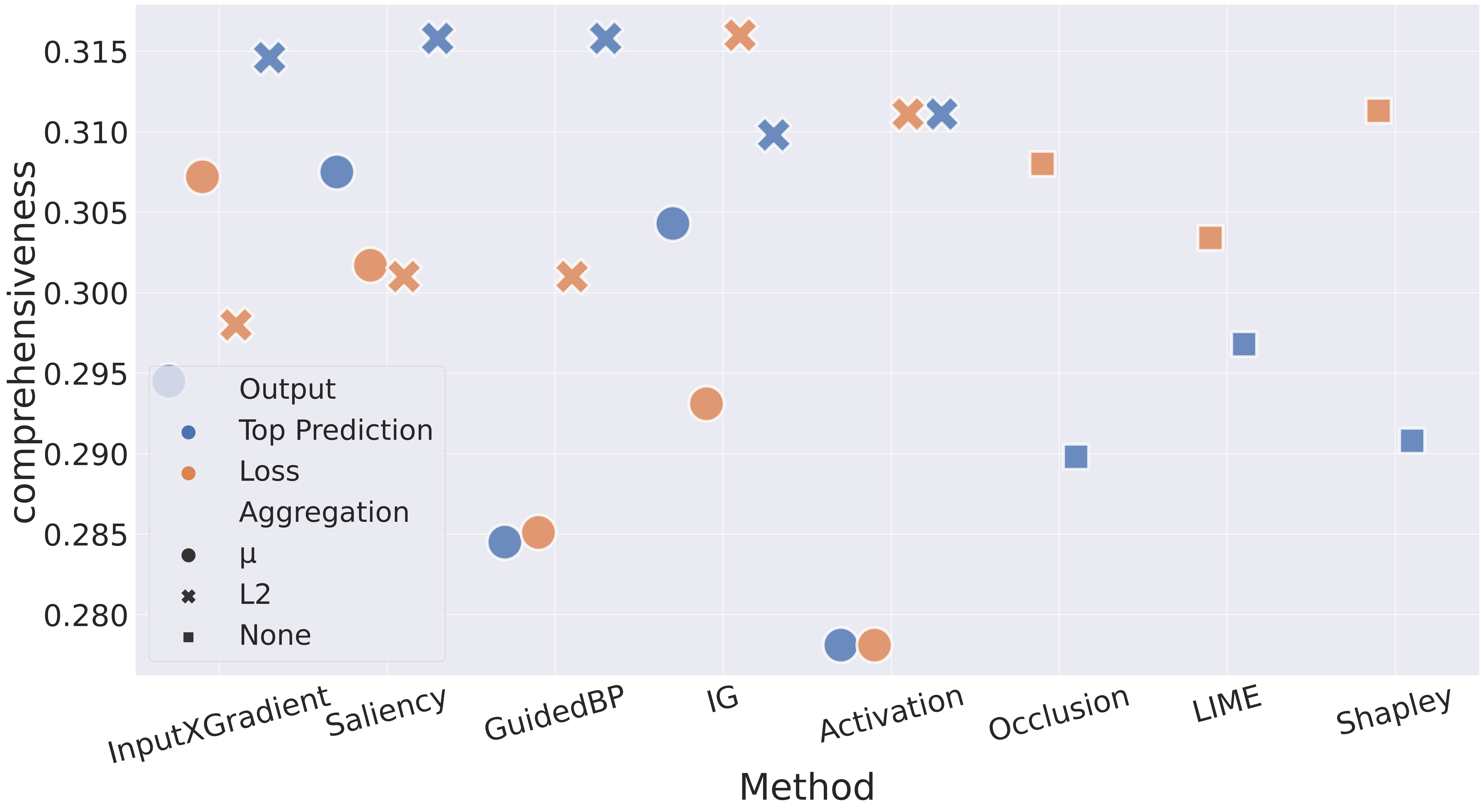Experiments
Faithfulness
Cross-lingual Faithfulness
Results

- InputXGradient is the most faithful method for both output types.
- Gradient-based ones usually generate more faithful attributions than perturbation-based ones.
- L2 aggregation is better than mean aggregation in almost all cases.
Reproducing Experiments
usage: run_cf.py [-h] [--output {tp,loss}] [--agg {mean,sum,l2}]
[--model MODEL] [--alignments ALIGNMENTS]
[--alignments-set {best,worst}]
[--method {ig,inputxgrad,saliency,activation,guided_bp,shapley,lime,occlusion}]
[--device DEVICE] [--batch-size BATCH_SIZE]
[--output-dir OUTPUT_DIR] [--n-steps N_STEPS]
Run crosslingual faithfulness experiments
optional arguments:
-h, --help show this help message and exit
--output {tp,loss} Output mechanism
--agg {mean,sum,l2} Aggregation method
--model MODEL Path to finetuned model
--alignments ALIGNMENTS
Path to alignments
--alignments-set {best,worst}
Type of alignments whether it is for best or worst
performing set of languages
--method {ig,inputxgrad,saliency,activation,guided_bp,shapley,lime,occlusion}
Attribution method
--device DEVICE device
--batch-size BATCH_SIZE
Batch size used for attribution calculation,
automatically set to 1 for some methods regardless of
choice
--output-dir OUTPUT_DIR
Path to directory to save results
--n-steps N_STEPS IntegratedGradients number of steps
ERASER Scores
Results
Comprehensiveness

- When the output is the top prediction score Saliency and GuidedBackprop with L2 aggregation are the most faithful methods.
- When the output is loss IntegratedGradients with L2 aggregation is the most faithful method.
- Loss as output usually performs better for non-gradient-based methods.
Sufficiency

- InputXGradient with L2 aggregation and IntegratedGradients with mean aggregation are the most faithful methods when the output is top prediction score and loss, respectively.
- No clear distinction between aggregation methods and output mechanisms.
Reproducing Experiments
usage: run_eraser.py [-h] [--output {tp,loss}] [--agg {mean,sum,l2}]
[--model MODEL]
[--method {ig,inputxgrad,saliency,activation,guided_bp,shapley,lime,occlusion}]
[--device DEVICE] [--batch-size BATCH_SIZE]
[--output-dir OUTPUT_DIR] [--n-steps N_STEPS]
Run ERASER experiments
optional arguments:
-h, --help show this help message and exit
--output {tp,loss} Output mechanism
--agg {mean,sum,l2} Aggregation method
--model MODEL Path to finetuned model
--method {ig,inputxgrad,saliency,activation,guided_bp,shapley,lime,occlusion}
Attribution method
--device DEVICE device
--batch-size BATCH_SIZE
Batch size used for attribution calculation,
automatically set to 1 for some methods regardless of
choice
--output-dir OUTPUT_DIR
Path to directory to save results
--n-steps N_STEPS IntegratedGradients number of steps
Cross-lingual Faithfulness vs Erasure-based Faithfulness
- Perturbation-based methods show more faithful explanations when evaluated by erasure-based metrics than when evaluated by cross-lingual faithfulness.
- Erasure-based faithfulness metrics fail to properly distinguish between different attribution methods since the differences are dwarfed due to the noise caused by OOD perturbations.
Plausibility

- GuidedBackprop with L2 aggregation for the top prediction score as output and Saliency with both types of aggregation methods for loss as output are the most plausible methods.
- Gradient-based methods usually generate more plausible explanations than perturbation-based ones.
- Loss as output is mostly better for the non-gradient-based methods.
- L2 is better than mean aggregation for almost all cases.
Reproducing Experiments
usage: run_ha.py [-h] [--output {tp,loss}] [--agg {mean,sum,l2}]
[--method {ig,inputxgrad,saliency,activation,guided_bp,shapley,lime,occlusion}]
[--model MODEL] [--dataset-dir DATASET_DIR]
[--split {dev,test}] [--device DEVICE]
[--batch-size BATCH_SIZE] [--output-dir OUTPUT_DIR]
[--n-steps N_STEPS]
Run human agreement experiments.
optional arguments:
-h, --help show this help message and exit
--output {tp,loss} Output mechanism
--agg {mean,sum,l2} Aggregation method
--method {ig,inputxgrad,saliency,activation,guided_bp,shapley,lime,occlusion}
Attribution method
--model MODEL Path to finetuned model
--dataset-dir DATASET_DIR
Path to the directory in which the e-SNLI dataset
exists
--split {dev,test} dev/test split
--device DEVICE device
--batch-size BATCH_SIZE
Batch size used for attribution calculation,
automatically set to 1 for some methods regardless of
choice
--output-dir OUTPUT_DIR
Path to directory to save results
--n-steps N_STEPS IntegratedGradients number of steps